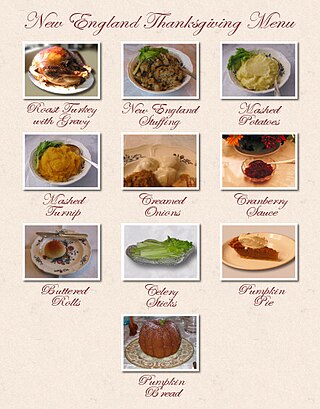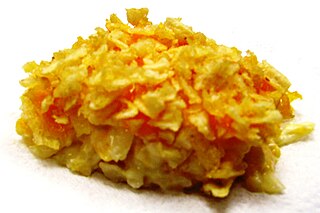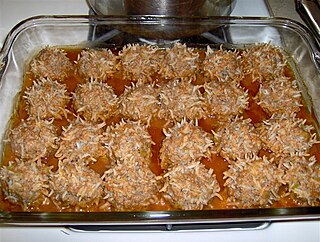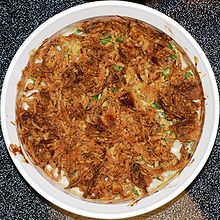
New England cuisine is an American cuisine which originated in the New England region of the United States, and traces its roots to traditional English cuisine and Native American cuisine of the Abenaki, Narragansett, Niantic, Wabanaki, Wampanoag, and other native peoples. It also includes influences from Irish, French-Canadian, Italian, and Portuguese cuisine, among others. It is characterized by extensive use of potatoes, beans, dairy products and seafood, resulting from its historical reliance on its seaports and fishing industry. Corn, the major crop historically grown by Native American tribes in New England, continues to be grown in all New England states, primarily as sweet corn although flint corn is grown as well. It is traditionally used in hasty puddings, cornbreads and corn chowders.

Polish cuisine is a style of food preparation originating in and widely popular in Poland. Due to Poland's history, Polish cuisine has evolved over the centuries to be very eclectic, and shares many similarities with other national cuisines. Polish cooking in other cultures is often referred to as à la polonaise.

Lithuanian cuisine features products suited to the cool and moist northern climate of Lithuania: barley, potatoes, rye, beets, greens, berries, and mushrooms are locally grown, and dairy products are one of its specialties. Various ways of pickling were used to preserve food for winter. Soups are extremely popular, and are widely regarded as the key to good health. Since it shares its climate and agricultural practices with Northern Europe, Lithuanian cuisine has much in common with its Baltic neighbors and, in general, northern countries.

Ukrainian cuisine is the collection of the various cooking traditions of the people of Ukraine, one of the largest and most populous European countries. It is heavily influenced by the rich dark soil (chornozem) from which its ingredients come, and often involves many components. Traditional Ukrainian dishes often experience a complex heating process – "at first they are fried or boiled, and then stewed or baked. This is the most distinctive feature of Ukrainian cuisine".

Kugel is a baked casserole, most commonly made from lokshen or potato. It is a traditional Ashkenazi Jewish dish, often served on Shabbos and Jewish holidays. American Jews also serve it for Thanksgiving dinner.

Comfort food is food that provides a nostalgic or sentimental value to someone and may be characterized by its high caloric nature associated with childhood or home cooking. The nostalgia may be specific to an individual or it may apply to a specific culture.

A hotdish or hot dish is a casserole dish that typically contains a starch, a meat, and a canned or frozen vegetable mixed with canned soup. The dish originates in the Upper Midwest region of the United States, where it remains popular, particularly in Minnesota, South Dakota, Wisconsin, North Dakota, and eastern Montana. Hotdish is cooked in a single baking dish, and served hot. It commonly appears at communal gatherings such as family reunions, potlucks, and church suppers. A classic example known as "tater tot hotdish" is made with ground beef, topped with tater tots, and flavored with thick, condensed cream of mushroom soup sauce.

The centerpiece of contemporary Thanksgiving in the United States is Thanksgiving dinner, a large meal generally centered on a large roasted turkey. Thanksgiving could be considered the largest eating event in the United States as measured by retail sales of food and beverages and by estimates of individual food intake. People often consume as much as three or four thousand calories during the course of the dinner.

Assyrian cuisine is the cuisine of the indigenous ethnic Assyrian people, Eastern Aramaic-speaking Syriac Christians of Iraq, northeastern Syria, northwestern Iran and southeastern Turkey. Assyrian cuisine is primarily identical to Iraqi/Mesopotamian cuisine, as well as being very similar to other Middle Eastern and Caucasian cuisines, as well as Greek cuisine, Levantine cuisine, Turkish cuisine, Iranian cuisine, Palestinian cuisine, and Armenian cuisine, with most dishes being similar to the cuisines of the area in which those Assyrians live/originate from. It is rich in grains such as barley, meat, tomato, herbs, spices, cheese, and potato as well as herbs, fermented dairy products, and pickles.

Tuna casserole is a casserole primarily made with pasta or rice and canned tuna, with peas sometimes added. The dish is often topped with potato chips, corn flakes, breadcrumbs or canned fried onions. Tuna casserole is a common dish in some parts of the United States, often prepared using only nonperishable pantry ingredients.

Ghanaian cuisine refers to the meals of the Ghanaian people. The main dishes of Ghana are centered around starchy staple foods, accompanied by either sauce or soup as well as a source of protein. The primary ingredients for the vast majority of soups and stews are tomatoes, hot peppers, and onions. As a result of these main ingredients, most Ghanaian soups and stews appear red or orange.

Afghan cuisine is influenced to a certain extent by Persian, Central Asian and Indian cuisines due to Afghanistan's close proximity and cultural ties. The cuisine is halal and mainly based on mutton, beef, poultry and fish with rice and Afghan bread. Accompanying these are common vegetables and dairy products, such as milk, yogurt, and whey, and fresh and dried fruits such as apples, apricots, grapes, bananas, oranges, plums, pomegranates, sweet melons, and raisins. The diet of most Afghans revolves around rice-based dishes, while various forms of naan are consumed with most meals. Tea is generally consumed daily in large quantities, and is a major part of hospitality. The culinary specialties reflect the nation's ethnic and geographic diversity. The national dish of Afghanistan is Kabuli palaw, a rice dish cooked with raisins, carrots, nuts, and lamb or beef.

A nut roast or roasted nut loaf is a vegetarian dish consisting of nuts, grains, vegetable oils, broth or butter, and seasonings formed into a firm loaf shape or long casserole dish before roasting and often eaten as an alternative to a traditional British style roast dinner. It is popular with vegetarians at Christmas, as well as part of a traditional Sunday roast. Nut roasts are also made by Canadian and American vegetarians and vegans as the main dish for Thanksgiving or other harvest festival meals.

Cream of mushroom soup is a simple type of soup where a basic roux is thinned with cream or milk and then mushrooms or mushroom broth are added.

The cuisine of Minnesota is a type of Midwestern cuisine found throughout the state of Minnesota.

Funeral potatoes is a traditional potato hotdish or casserole that is popular in the American Intermountain West and Midwest. It is called "funeral" potatoes because it is commonly served as a side dish during traditional after-funeral dinners, but it is also served at potlucks, and other social gatherings, sometimes with different names. The dish has sometimes been associated with members of The Church of Jesus Christ of Latter-day Saints, because of its popularity among members of the Church.
Romani cuisine is the cuisine of the ethnic Romani people. There is no specific "Roma cuisine"; it varies and is culinarily influenced by the respective countries where they have often lived for centuries. Hence, it is influenced by European cuisine even though the Romani people originated from the Indian subcontinent. Their cookery incorporates Indian and South Asian influences, but is also very similar to Hungarian cuisine. The many cultures that the Roma contacted are reflected in their cooking, resulting in many different cuisines. Some of these cultures are Middle European, Germany, Great Britain, and Spain. The cuisine of Muslim Romani people is also influenced by Balkan cuisine and Turkish cuisine. Many Roma do not eat food prepared by a non-Roma.
Dorcas Lillian Bates Reilly was an American chef, homemaker, and inventor. Reilly worked for several years in the Campbell's Test Kitchen creating new recipes. She is best known for popularizing the green bean casserole. Reilly was called the "Grandmother of the Green Bean Bake."

Porcupine meatballs are an American casserole dish of ground beef and rice meatballs cooked in tomato sauce. They were a staple during the Great Depression requiring only a few basic ingredients: ground beef, uncooked long-grain rice, onion, and canned tomato soup. The name comes from the appearance of the meatballs, which appear prickly when the rice pokes out of them as they cook, resembling a porcupine.

















